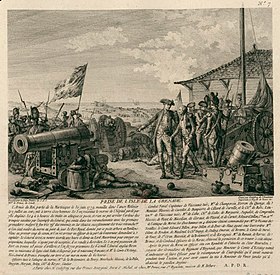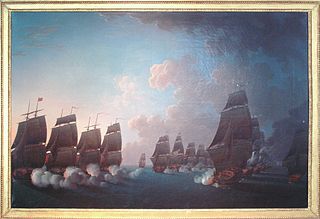
The Battle of Martinique, also known as the Combat de la Dominique, took place on 17 April 1780 during the American Revolutionary War in the West Indies between the British Royal Navy and the French Navy.

The Battle of Fort Royal was a naval battle fought off Fort Royal, Martinique in the West Indies during the Anglo-French War on 29 April 1781, between fleets of the British Royal Navy and the French Navy. After an engagement lasting four hours, the British squadron under Admiral Samuel Hood broke off and retreated. Admiral de Grasse offered a desultory chase before seeing the French convoys safe to port.

The Battle of St. Lucia or the Battle of the Cul de Sac was a naval battle fought off the island of St. Lucia in the West Indies during the American Revolutionary War on 15 December 1778, between the British Royal Navy and the French Navy.

HMS Ardent was a 64-gun third-rate ship of the line of the Royal Navy. She was built by contract at Blaydes Yard in Hull according to a design by Sir Thomas Slade, and launched on 13 August 1764 as the first ship of the Ardent-class. She had a somewhat turbulent career, being captured by the French in the action of 17 August 1779, and then re-captured by Britain in 1782.

The Fantasque was a Lion-class 64-gun ship of the line of the French Navy. She is famous for being captained by the French commander Pierre-André de Suffren during the American Revolutionary War.

The Conquérant was originally designed and built by François Coulomb the Younger at Toulon from 1745 to 1747, as a modified version of the same constructor's Terrible built at the same dockyard in 1736-40. In need of major repairs by early 1755, she was not employed throughout the Seven Years' War, after which she was formally taken out of service on 17 March 1764 and was rebuilt by Joseph-Louis Ollivier at Brest from January to December 1765 as a Citoyen-class 74-gun ship of the line of the French Navy.
HMS Boyne was a 70-gun third rate ship of the line of the Royal Navy, built at Plymouth Dockyard to the draught specified in the 1745 Establishment as amended in 1754, and launched on 31 May 1766. She was first commissioned for the Falkland Crisis of 1770 after which, in 1774, she sailed for North America. From March 1776, she served in the English Channel then, in May 1778, she was sent to the West Indies where she took part in the battles of St Lucia, Grenada and Martinique. In November 1780, Boyne returned home, where she was fitted for ordinary at Plymouth. In May 1783, she was broken up.
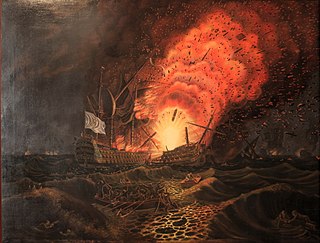
César was a 74-gun ship of the French Navy. Ordered in the spring of 1767 from the Toulon shipyard, she was launched on 3 August 1768. César saw service in the American War of Independence, during which she was destroyed in the Battle of the Saintes.

Hector was a 74-gun ship of the line of the French Navy, lead ship of her class. Hector was launched in 1755 and fought in the American Revolutionary War during which she captured two ships of the British Royal Navy on 14 August 1778. In 1782, the ship was captured by the Royal Navy at the Battle of the Saintes in 1782. Taken into service by the Royal Navy, the vessel was renamed HMS Hector. On 5 September 1782. HMS Hector fought two French frigates. Severely damaged during the battle, and by a hurricane that followed later in September, Hector sank on 4 October 1782.

The Capture of Grenada was an amphibious expedition in July 1779 during the American Revolutionary War. Charles Hector, comte D'Estaing led French forces against the British-held West Indies island of Grenada. The French forces landed on 2 July and the assault occurred on the night of 3–4 July. The French forces assaulted the British fortifications on Hospital Hill, overlooking the island's capital, Saint George's. The British cannons were captured and turned against Fort George. British Governor Lord Macartney opened negotiations to surrender.
The Capture of Saint Vincent was a French invasion that took place between 16 and 18 June 1779 during the American Revolutionary War. A French force commander named Charles-Marie de Trolong du Rumain landed on the island of Saint Vincent in the West Indies and quickly took over much of the British-controlled part of the island, assisted by local Black Caribs who held the northern part of the island.
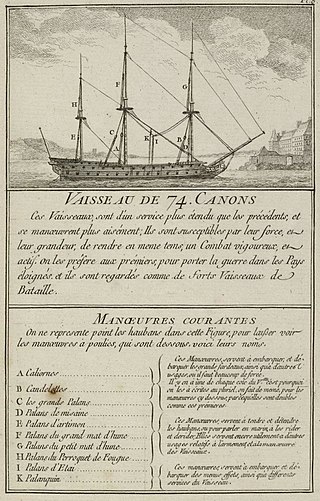
Palmier was a 74-gun ship of the line of the French Navy.
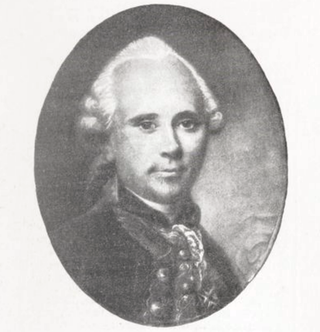
François Hector d’Albert, comte de Rioms or Rions was a French Navy officer. He served in the War of American Independence, earning a membership in the Society of Cincinnati.

Éveillé was an Artésien-class 64-gun ship of the line of the French Navy, launched in 1772.
Armand Le Gardeur de Tilly was a French Navy officer. He served in the War of American Independence.

Joseph-Bernard de Chabert-Cogolin was a French Navy officer. He served in the War of American Independence.
François-Aymar de Monteil was a French Navy officer. He served in the War of American Independence, earning membership in the Society of the Cincinnati. He was also a member and director of the Académie de Marine.
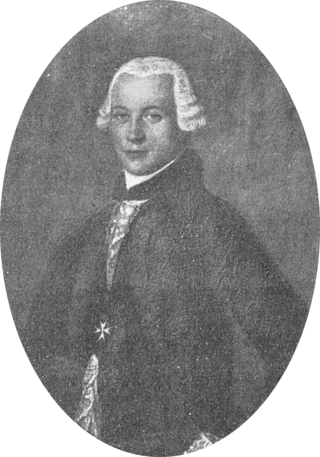
Charles-René de Gras-Préville was a French Navy officer. He served in the War of American Independence, earning membership in the Society of the Cincinnati.
Zodiaque was a 74-gun Diadème-class ship of the line of the French Navy.
Hippopotame was a 50-gun ship of the line of the French Navy, designed by François Coulomb the Younger. She served during the Seven Years' War. In 1777, Pierre Beaumarchais purchased her as part of a commercial entreprise to provide weapons of the American independentist insurgents. She was part of the French line of battle at the Battle of Grenada on 6 July 1779, and served as a hospital during the Siege of Savannah.

